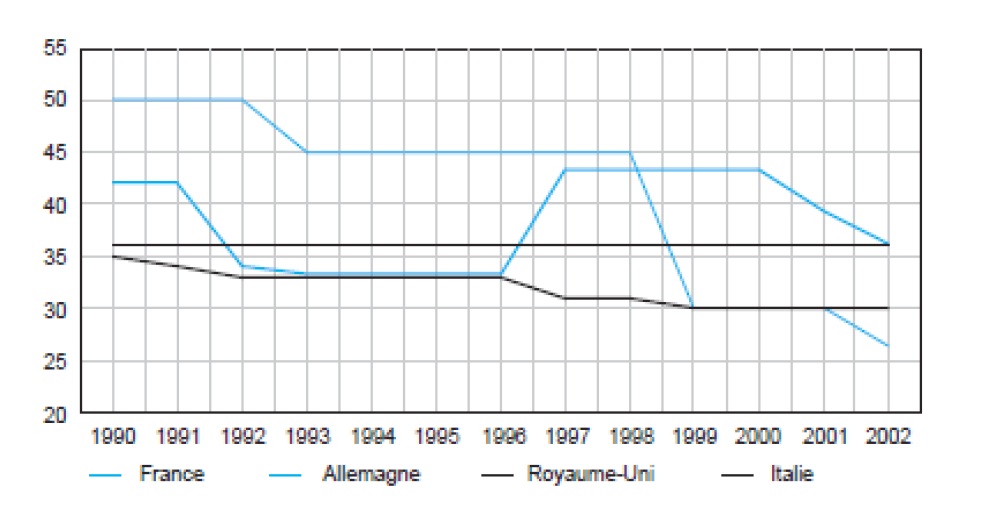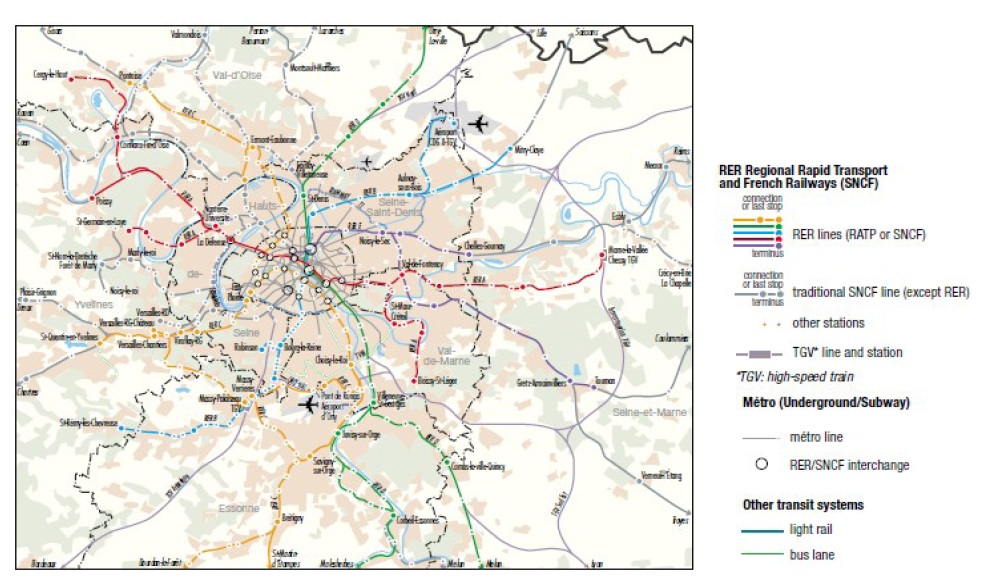Paris Ile-de-France has an industry with many firms with strong added value, even though the different
fields are not really diversified. The challenge for the region will be to help these companies to renew
their industry(44).
The region should also have a policy to attract the different global companies to implement offices.
Indeed, Paris needs to offer many facilities, in order to be an attractive place to establish a business in.
Because of the new coming of Eastern countries within the European Union, the city-region should
expand its offer, by creating new facilities to keep the prices low and be competitive. Indeed countries
as Poland are now important members in the EU, because of their size, and also for its closeness to
Germany (major economy of Europe). The new member states can offer facilities really competitive
regarding to the cost, this is why western cities, really have to work on their facilities offers(45).
London is now ranked as the first financial place in the world, which gives to the city many economic
advantages. The evolution of the Paris Stock Exchange is also one of the main challenges for the
region in order to become more competitive and attractive. Paris Stock Exchange has been established
in 1724, and was the second largest stock market just before the First World War (behind London, but
in front of New York and Berlin). Nowadays Paris stock market is considered as powerful due to
Euronext and its merger with NYSE in 2007 (with an estimated capitalisation of $1.362 billion).
The financial sector can be considered as essential for the global cities such as Paris. Even though while
the finance sector represents 11% of employment in New York and London, it does only represent
6.5% in Paris (and 4.5% in France). The region has the challenge to create more jobs in this field.
At the moment a large number of the French students with a financial formation go to work to London or
even New York. Paris Ile-de-France should be able to bring them back by improving the Parisian
financial environment to generate attractive careers. To do so, Paris should also work on its legal and
fiscal aspects, by pressuring the government to adapt its fiscal policies(46) and become more
competitive.
Indeed, the following exhibit shows a comparison of the company tax rate in France, German y, the
United Kingdom and Italy:
(47) Figure 5: Tax marginal rate on large companies

As we can see, the French corporate tax is the highest of the four countries, as the rate meets nearly
36% of the benefits distributed by the companies in 2002, the lowest rate being in Germany with 26%
(ten points under the French one). The companies also have this feeling has it is shown on the Ernst &
Young survey of 2003, as only 3% of the companies asked estimate the French tax policy as attractive
(against 33% of the companies asked in the United Kingdom)(48).
Another point really important to improve the situation of Paris is the public transport services.
Indeed, as mentioned in the report of Chambre de commerce et d’industrie de Paris (2008). The report
highlights the necessity to improve the link between the airport and the city centre, and also to
improve the different connections between the suburban towns around Paris(49).
The following graph is showing the existing infrastructures of Paris Ile-de-France. As we can notice,
the suburb is well connected to the centre, but there is a lack of connection between suburban towns.
Also, the main airport of Paris, do not have a permanent direct line, connecting the airport to the city
centre (Heathrow London main airport, has a fast line named Heathrow express to reach the city centre
from the airport within ten minutes). It is also clear, that the creation of a direct line to connect Paris
CDG to the main business area Paris-La Défense is essential.
(50) Figure 5 : Regional public transport services in Paris

Indeed, many researchers have shown the importance of transports to the economic growth..
According to Cambridge Systematics and the Economic development agency, Transportations
represents 17% of the US Growth Domestic Product, and is the second most important spend of
American families (18% of the expenditures). The research highlights also the congestion effects,
which are qualified as really costly, it represented in the USA (1999) a scale of $40 to $100 billion per
year, as it increased costs and reduce business profitability and strongly decreased the economic
attractiveness of the country. The lack of transportation linkage also strongly affects environmental
and quality of life of the different workers using the transports, in term of access to work, but also a
lack of transportation services, and traffic strongly increases the prices, which is also a lack of
business competitiveness(51).
As shown, the transportations have a strong impact on the overall economy. In the study of Cambridge
systematic and Economic Development Research Group, the theory of Direct Dollar Effects and
Multipliers are explained.
“Direct” investment directly impacts the economy, by creating jobs in order to build a transportation
project. An investment does also have an “Indirect” effect by spending money to suppliers which
provide goods and raw materials. These two investment types will create a growth of the incomes of
the households by creating revenues on a permanent term as theses project will be a generator of
hiring in order to support the operations on the projects. The raise of transportation projects can also
generate on the long term an economy of scale, which will also benefits to the users(52).
The combination of these spending will do a “multiplier effect”, which in practical terms means the
stimulation of the economy by generating the creation of new businesses, the expansion of existing
businesses and will give more attractiveness to the city/region/country for Foreign Direct Investment.
(53) Figure 6: Multiplier effect:

The general findings of Cambridge systematic are that the transit investment, decreased travel time,
decreases the congestion and increase safety for people. These factors generate a decrease of
transportation costs which lead to a decrease of business costs, and also a decrease of the cost of
living. On a personal life of employee point of view, as the reduction of the journey time to work
decreased, it leads to a better productivity at work, so we can assume that it lowers the prices and costs
of company’s production which leads to a better positioning of the companies in the area concerned by
the transit investment to be more willing to trade off with foreign companies. As it stipulates in the
article, there is an economic simulation (business expansion and attraction). The government will also
thanks to its investment get some tax benefits, as the amounts which will be perceived will be higher
(sales taxes, income taxes and property taxes)(54).
Indeed it has been analysed in the report of Cambridge systematic, that on a short run, $10 million
invested would generate 314 jobs, and companies would perceived a gain three times more important
than the investment (in this example, a $10 million in transit investment would generate a gain of $30
million of sales)(55). The research also mentions that every $10 million invested, will permit to save $15
million in transportation costs for all the public transports users(56).
The challenge here for Paris Ile-de-France is really clear, by investing in public transportations and
circulation structures, it will lead to improve of the international sales of the Parisians companies. The
region should also have some benefits regarding to the attraction of companies to the region, by
creating some jobs and increasing taxes.
Regarding to the results of the research paper, a transit investment can strongly stimulate the economy.
If we adapt this simulation to the case of le Grand Paris, the results are also really optimistic. Indeed
with an investment of €22 billion of Euros to expand the public transports in the Grand Paris project, it
would generate 690800 jobs, companies should gain €66 billion in sales, and the users would save €33
billion.
Obviously these results are not realistic, as the study cannot be applied seriously to our case.
Nevertheless it gives an idea of how important could be the Grand Paris project for the region’s
welfare.
As mentioned in the report of Chambre de commerce et d’industrie de Paris, Paris has to reinforce its
attractiveness thanks to its emblematic sectors(57). The agency proposed different ideas such as the
creation of a slogan, as territorial marketing is seen as one of the major aspects to reinforce the city
position in the world competition (ex: New York has its famous slogan “I love New York”).
The agency proposes to give a more important role to the mayor of Paris (by comparison the mayors
of New York and London are more mediatised). He could become a real ambassador of the city/region
in the world. Paris should also build buildings done by famous architects, as it is also an important
vector of communication. Indeed at the moment even with all the strengths that the city proposed, we
can easily see an unfair under estimation of Paris economics certainly because of a lack of visibility.
A simple example to show this issue is to measure the visibility of the Paris economics figures on
internet: by looking for “Paris economy” on a web site browser, only 72 web sites talking about are
found against 1659 for London. This is explained by the uninteresting of the economists for the
region(58).
The Greater Paris will also have to give an image of a front-rank city.
44 Chambre de commerce et d’industrie de Paris, « Quelle ambition pour l’économie Parisienne ? »,CCI Paris,
2008. P.P.28
45 Ibid P.P. 33
46 Pierre-Cyrille Hautcoeur, Maude Sainteville, « Paris, métropole financière : quels enjeux pour le
développement durable ? », Paris, métropole durable, 2009, P.P. 2-9.
47 Banque de France, « L’attractivité de la France au travers d’une sélection d’indicateurs », Bulletin De la
banque de France, Mars 2004, P.P 82.
48 Ibid, P.P. 83.
49 Chambre de commerce et d’industrie de Paris, « Quelle ambition pour l’économie Parisienne ? », 2008. P.P 22
50 Paris Region Economic development agency, Paris Region Key Figures, 2011, PP.22
51 Cambridge Systematic and Economic Development Research Group, « Public Transportation and the Nation’s
Economy », Business Members of the American Public Transit Association, 1999, P.P 7
52 Ibid P.P E-5
53 Ibid P.P E-4
54 Cambridge Systematic and Economic Development Research Group, « Public Transportation and the Nation’s
Economy », P.P. 7
55 Ibid P.P.2-1
56 Ibid P .P.4-1
57 Chambre de commerce et d’industrie de Paris, « Quelle ambition pour l’économie Parisienne ? », 2008. P.P 54
58 Laurent Davezies, Croissance sans développement en Ile-de-France, OEil-Créteil-Université Paris 12, 2007, PP.1
Page suivante : B-b The demand of the President Sarkozy.
Retour au menu : LE GRAND PARIS How would this project generate an economic growth?
